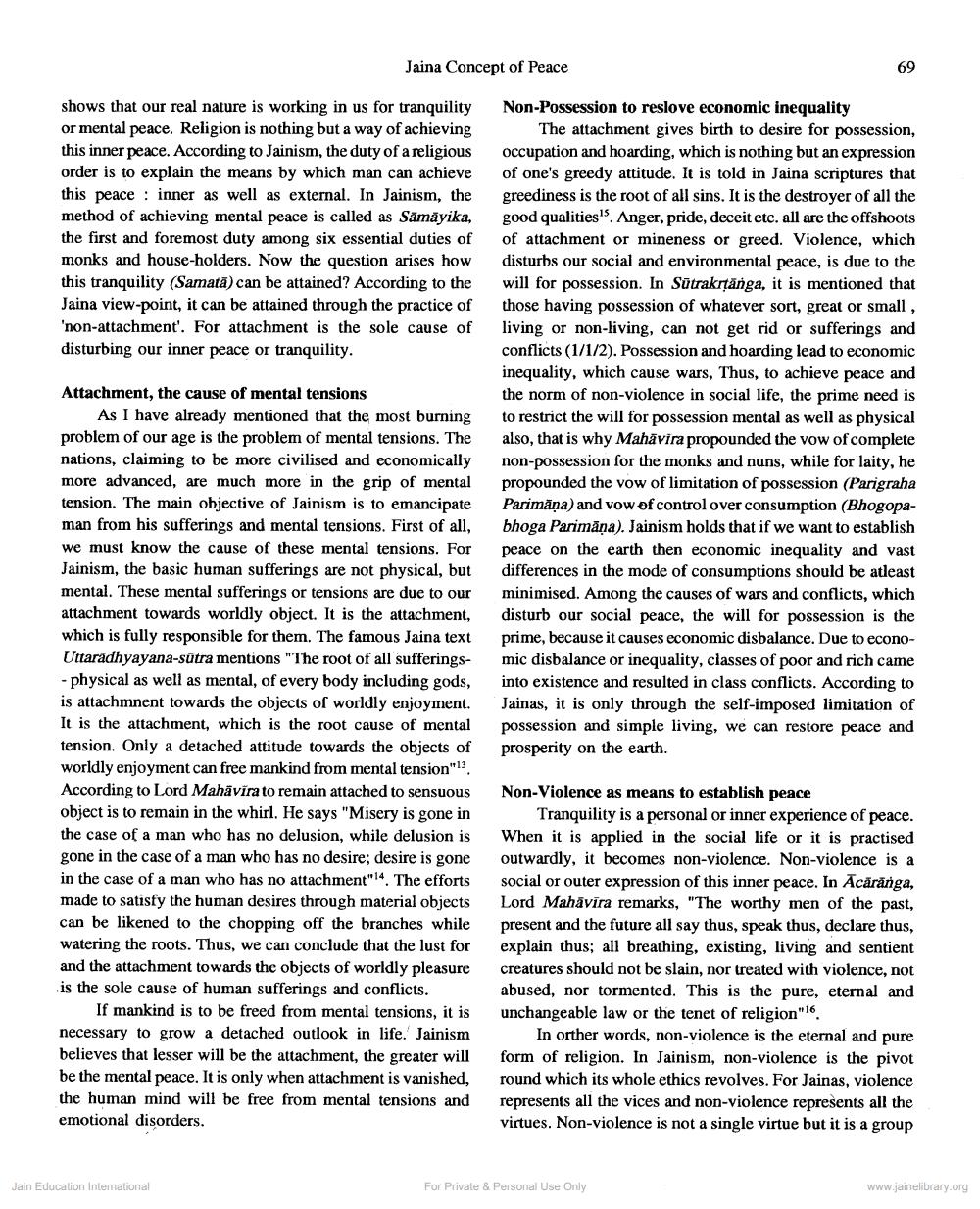Book Title: Jaina Concept Of Peace Author(s): Sagarmal Jain Publisher: Z_Jaina_Literature_and_Philosophy_a_Critical_Approach_001936_HR.pdf View full book textPage 4
________________ Jaina Concept of Peace 69 shows that our real nature is working in us for tranquility or mental peace. Religion is nothing but a way of achieving this inner peace. According to Jainism, the duty of a religious order is to explain the means by which man can achieve this peace : inner as well as external. In Jainism, the method of achieving mental peace is called as Sāmāyika, the first and foremost duty among six essential duties of monks and house-holders. Now the question arises how this tranquility (Samatā) can be attained? According to the Jaina view-point, it can be attained through the practice of 'non-attachment'. For attachment is the sole cause of disturbing our inner peace or tranquility. Attachment, the cause of mental tensions As I have already mentioned that the most burning problem of our age is the problem of mental tensions. The nations, claiming to be more civilised and economically more advanced, are much more in the grip of mental tension. The main objective of Jainism is to emancipate man from his sufferings and mental tensions. First of all, we must know the cause of these mental tensions. For Jainism, the basic human sufferings are not physical, but mental. These mental sufferings or tensions are due to our attachment towards worldly object. It is the attachment, which is fully responsible for them. The famous Jaina text Uttaradhyayana-sutra mentions "The root of all sufferings- - physical as well as mental, of every body including gods, is attachmnent towards the objects of worldly enjoyment. It is the attachment, which is the root cause of mental tension. Only a detached attitude towards the objects of worldly enjoyment can free mankind from mental tension". According to Lord Mahāvīra to remain attached to sensuous object is to remain in the whirl. He says "Misery is gone in the case of a man who has no delusion, while delusion is gone in the case of a man who has no desire; desire is gone in the case of a man who has no attachment". The efforts made to satisfy the human desires through material objects can be likened to the chopping off the branches while watering the roots. Thus, we can conclude that the lust for and the attachment towards the objects of worldly pleasure is the sole cause of human sufferings and conflicts. If mankind is to be freed from mental tensions, it is necessary to grow a detached outlook in life. Jainism believes that lesser will be the attachment, the greater will be the mental peace. It is only when attachment is vanished, the human mind will be free from mental tensions and emotional disorders. Non-Possession to reslove economic inequality The attachment gives birth to desire for possession, occupation and hoarding, which is nothing but an expression of one's greedy attitude. It is told in Jaina scriptures that greediness is the root of all sins. It is the destroyer of all the good qualities. Anger, pride, deceit etc. all are the offshoots of attachment or mineness or greed. Violence, which disturbs our social and environmental peace, is due to the will for possession. In Sūtrakrţănga, it is mentioned that those having possession of whatever sort, great or small, living or non-living, can not get rid or sufferings and conflicts (1/1/2). Possession and hoarding lead to economic inequality, which cause wars, Thus, to achieve peace and the norm of non-violence in social life, the prime need is to restrict the will for possession mental as well as physical also, that is why Mahāvira propounded the vow of complete non-possession for the monks and nuns, while for laity, he propounded the vow of limitation of possession (Parigraha Parimāņa) and vow of control over consumption (Bhogopabhoga Parimāna). Jainism holds that if we want to establish peace on the earth then economic inequality and vast differences in the mode of consumptions should be atleast minimised. Among the causes of wars and conflicts, which disturb our social peace, the will for possession is the prime, because it causes economic disbalance. Due to economic disbalance or inequality, classes of poor and rich came into existence and resulted in class conflicts. According to Jainas, it is only through the self-imposed limitation of possession and simple living, we can restore peace and prosperity on the earth. Non-Violence as means to establish peace Tranquility is a personal or inner experience of peace. When it is applied in the social life or it is practised outwardly, it becomes non-violence. Non-violence is a social or outer expression of this inner peace. In Acaranga, Lord Mahavira remarks, "The worthy men of the past, present and the future all say thus, speak thus, declare thus, explain thus; all breathing, existing, living and sentient creatures should not be slain, nor treated with violence, not abused, nor tormented. This is the pure, eternal and unchangeable law or the tenet of religion"16. In orther words, non-violence is the eternal and pure form of religion. In Jainism, non-violence is the pivot round which its whole ethics revolves. For Jainas, violence represents all the vices and non-violence represents all the virtues. Non-violence is not a single virtue but it is a group Jain Education International For Private & Personal Use Only www.jainelibrary.orgPage Navigation
1 2 3 4 5 6 7 8
